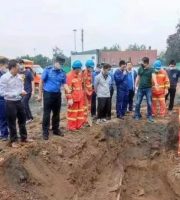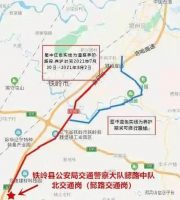The construction process of municipal water supply and drainage pipeline engineering: slotted construction → non slotted construction → pipeline installation → ancillary facilities → functional experiment → maintenance and repair 1
. 
Slotted pipeline construction: trench excavation (grading / enclosure) – trench inspection – trench bottom reinforcement – cushion construction; it belongs to the relevant knowledge points of foundation pit engineering
. 
2
. 
Non slotted pipe construction: pipe jacking, shield, shallow excavation, directional drilling, ramming pipe 3
. 
Pipe installation: PE pipe hot-melt or electric fusion connection is adopted for water supply pipe, precast concrete pipe and socket connection are adopted for drainage pipe
. 
4
.
Ancillary facilities: Channel / pipe channel, process well, gate well, inspection well, pay attention to the construction requirements of masonry engineering
.
5
.
Functional test: pressure pipeline water pressure test, non pressure pipeline tightness test, water supply pipeline flushing and disinfection
.
6
.
Maintenance and repair: local repair (sealing method, patching method, hinged pipe method, local soft lining method, grouting method, robot method) full section repair (lining method, winding method, spraying method); pipeline renewal (broken pipe extrusion, broken pipe jacking) common problems in municipal water supply and drainage construction 1
.
The preparation work is not in place, the construction unit is not careful and in-depth on-site investigation, resulting in quality control The plan is not reasonable, as well as the construction period, inspection procedures and methods, quality control points and control levels
.
2
.
There are some problems in the design of settling well
.
During the construction design of water supply and drainage pipes in some municipal engineering, there is no independent design for settling well, which often leads to the blockage of drainage pipes in municipal engineering
.
3
.
The construction scheme of drainage well is not perfect, if there is no scientific and reasonable design for the construction scheme, it is easy to cause the travel of citizens to be hindered
.
In addition, in the process of drainage well construction, there is often a certain amount of gravel residue
.
4
.
Material and process problems, quality defects of construction equipment and engineering materials: aging and corrosion of pipes and components, trachoma and other phenomena
.
Defects in the construction process: defects in the construction process and technical level, resulting in insufficient processing accuracy of pipe fittings, lax sealing or slope problems
.
Serious settlement of backfill: the backfill compaction operation is not in place, the soil stability and strength are not up to standard, and the water content exceeds the standard, resulting in serious settlement of backfill
.
The common quality problems of municipal water supply and drainage pipeline are to prevent the causes of pipeline position deviation or ponding, measurement errors, construction aliasing and accidental avoidance of original structures, resulting in position deviation on the plane, ponding or even slope fall on the facade
.
Prevention and control measures (1) before construction, the handover pile shall be retested and protected in accordance with the construction survey specifications and procedures
.
(2) The construction lofting shall be carried out in combination with the hydrogeological conditions, according to the burial depth, design requirements and relevant regulations, and shall be delivered for construction after retesting and checking that the error meets the requirements
.
(3) The construction shall be carried out in strict accordance with the sample pile, and the axis and longitudinal slope of trench and foundation shall be measured and accepted
.
In the process of construction, if it is necessary to avoid structures, a connecting well should be added at an appropriate position, which should be connected by a straight line, and the angle of the connecting well should be greater than 135 degrees
.
The causes of pipe leakage, unqualified closed water test, uneven foundation sinking, poor quality of pipe and its interface construction, poor sealing of closed water section end, poor quality of well construction, etc
.
Prevention measures: 1
.
Poor pipeline foundation conditions: (1) construction shall be carried out according to the design requirements seriously, and when the geological and hydrological conditions of the foundation are poor, the soil shall be replaced and improved; (2) if the soil at the bottom of the trench is disturbed or soaked in water, the soft soil layer shall be excavated first, and then the over excavated part shall be backfilled with sand, gravel and other stable materials; (3) when the earthwork is excavated below the groundwater level, the bottom of the trench shall be well prepared If necessary, a 20 cm thick soil layer can be reserved at the bottom of the trench, which can be removed as soon as the excavation is carried out
.
2
.
The quality of the pipes is poor (1) the pipes used must have a quality qualification report; (2) the appearance quality of the pipes meets the requirements; (3) the pipes are inspected section by section before installation
.
3
.
The quality of pipe joint filler and construction is poor
.
(1) good quality joint filler should be selected according to the test mix proportion and reasonable construction technology; (2) the joint joint should be clean and roughened when necessary
.
4
.
The construction quality of the inspection well is poor
.
(1) the masonry mortar of the inspection well is full, and the joints are not missed completely; the surface shall be cleaned and wetted before plastering, and the slurry shall be polished and cured in time during plastering; when there is underground water, the plastering and joints shall be completed in time with the masonry, and the internal plastering or joints shall not be carried out after backfilling; (2) the outer surface of the pipe connected with the inspection well shall be wetted and evenly brushed with one layer After the cement slurry is in place, the internal and external plastering shall be done to prevent leakage
.
5
.
The sealing of the planned reserved branch pipe is not dense
.
(1) before blocking, the inner wall of the pipe within 0.5m of the pipe orifice shall be cleaned, and the original cement slurry shall be painted, and the bricks used shall be wetted for standby; (2) the grade of the blocking mortar shall not be lower than M7.5 with good consistency; (3) the grade of the cement mortar used for pointing and plastering shall not be lower than M15
.
When the pipe diameter is large, the inner and outer sides should be small, only the outer side should be pointed or plastered, and the plastering should be constructed according to the waterproof five layer construction method; (4) generally, the inspection well should be sealed before masonry
.
The reasons for the deformation and sinking of the inspection well, the poor quality of components and fittings, the poor quality of the manhole cover and installation, and the random installation of the ladder in the well
.
Prevention and control measures (1) do a good job in the base and cushion of the inspection well, break the pipe to make the flow channel, to prevent the well sinking
.
(2) The location and height of well chamber and wellhead center should be well controlled to prevent well deformation
.
(3) The manhole cover and the seat should be matched; the slurry should be full during the installation; the light and heavy models and the surface and bottom should be used well; the position of the upper and lower steps should be well controlled during the installation of the iron climbing, and the plane position should be accurate
.
The causes of backfill settlement are as follows: the backfill around the inspection well is not dense, the filling is not compacted in layers according to the requirements, the filling quality is poor, and the water content is not well controlled, which affect the compaction effect and cause excessive settlement
.
Preventive measures 1
.
Prevention (1) when the pipe trench is backfilled, it is necessary to select suitable filling materials and compaction machinery according to the backfilled position and construction conditions
.
(2) When the trench is narrow, it can be filled by manual or frog rammer
.
In order to achieve the most economical compaction effect, different tamping tools should be selected for different filling materials and different filling thickness
.
(3) The silt, tree roots, turf and rotten plants in the filler not only affect the compaction effect, but also shrink and rot in the soil to form holes
.
These materials can not be used as filler to avoid settlement
.
(4) The water content of the filling material should be controlled to be 2% higher than the optimal water content; in case of underground water or rain, the water must be drained first, and then the filling and compaction should be carried out in layers
.
2
.
Treatment (1) do not affect the small amount of settlement of other structures, can not do treatment or only do surface treatment, such as asphalt pavement can take local filling to avoid ponding; (2) if it causes other structures foundation void damage, can use pump pressure cement slurry filling; (3) if it causes structural damage, should dig out bad filler, replace with good stability material, after compaction to restore damage Bad structure
.
~~Recommended reading ~ ~ municipal engineering road landscaping points, do you know the difference between construction drawing review, design disclosure and technical disclosure, and how to choose the three connection methods of key points reinforcement, which parts can not be welded, which parts can not be bound concrete structure wall, column, large volume construction joint, there are four principles.
.


